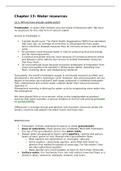Chapter 13: Water resources
13.1: Will we have enough usable water?
Freshwater, or water that contains very low levels of dissolved salts. We have
no substitute for this vital form of natural capital
Access to freshwater is
A global health issue. The World Health Organization (WHO) has estimated
that each day, an average of more than 4,100 people die from water-
borne infectious diseases because they do not have access to safe drinking
water.
An economic issue because water is vital for producing food and energy
and for reducing poverty.
A national and global security issue because of increasing tensions within
and between some nations over access to limited freshwater resources
that they share.
An environmental issue because excessive withdrawal of freshwater from
rivers and aquifers has resulted in falling water tables, dwindling river
flows, shrinking lakes, and disappearing wetlands.
Fortunately, the world’s freshwater supply is continually recycled, purified, and
distributed in the earth’s hydrologic cycle. However, this vital ecosystem service
begins to fail when we overload it with water pollutants or withdraw freshwater
from underground and surface water supplies faster than natural processes
replenish it.
Atmospheric warming is altering the water cycle by evaporating more water into
the atmosphere
We have placed little or no economic value on the irreplaceable ecosystem
services that water provides, a serious violation of the full-cost pricing principle
of sustainability
Differences in average annual precipitation and economic resources divide the
world’s countries and people into water haves and have-nots.
Watersources
Freshwater in these underground spaces is called groundwater
Zone of saturation, these spaces are completely filled with freshwater.
The top of this groundwater zone is the water table.
Deeper down are geological layers called aquifers, caverns and porous
layers of sand, gravel or rock through which groundwater flows
o Most aquifers are replenished, or recharged, naturally
o Some aquifers, called deep aquifers, were filled with water by
glaciers that melted thousands of years ago. For this reason, they
are also called fossil aquifers.
o Deep aquifers are nonrenewable, at least on the human timescale.
Surface water, the freshwater from rain and melted snow that flows or is
stored in lakes, reservoirs, wetlands, streams, and rivers.
, Precipitation that does not soak into the ground or re- turn to the
atmosphere by evaporation is called surface runoff
The land from which surface runoff drains into a particular stream, lake,
wetland, or other body of water is called its watershed, or drainage
basin.
Hydrologists, scientists who study water and its properties and movement, two-
thirds of the annual sur- face runoff of freshwater into rivers and streams is lost in
seasonal floods and is not available for human use. The remaining one-third is
reliable surface runoff, which we can generally count on as a source of
freshwater from year to year.
Water footprint is a rough measure of the volume of freshwater that we use or
pollute, directly and indirectly, to stay alive and to support our life- styles.
Freshwater that is not directly consumed but is used to produce food and other
products is called virtual water.
Because of global trade, the virtual water used to produce and transport products
(also called embedded water) is often
withdrawn as groundwater or surface
water in another part of the world
Freshwater scarcity stress is a measure based on the amount of freshwater
available compared to the amount used for human purposes
By 2059, as much as 45% of the earth’s land surface could experience an even
higher level of drought, called extreme drought, due to natural cycles and
projected climate change,
13.2: Is groundwater a sustainable resource?
Relying more on groundwater has advantages and disadvantages
+Useful for drinking and irrigation
+Exists almost everywhere
+Renewable if not overpumped or contaminated
+Cheaper to extract than most surface waters
-Aquifer depletion from overpumping
-Sinking of land (land subsidence) from overpumping sinkhole
-Some deeper aquifiers are nonrenewable
-Pollution of aquifers lasts decades or centuries
Overpumping aquifers contributes to limits on food pro- duction, rising food
prices, and widening gaps between the rich and poor in some areas. This in turn
can lead to rising hunger and social unrest
Also, as water tables drop, the energy and financial costs of pumping the water
from lower depths rise sharply because farmers must drill deeper wells, buy
larger pumps, and use more electricity to run the pumps.
Five major problems related to tapping these ancient deposits of freshwater
Nonrenewable on a human time skill




